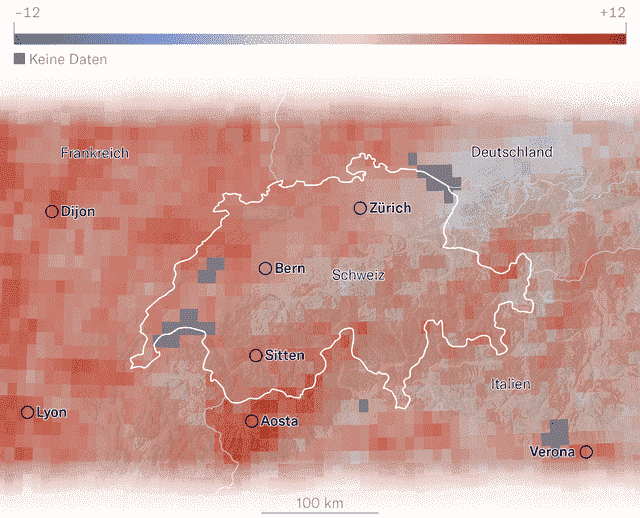The first heat wave of the year ends at the start of summer on June 21st. Almost as many tropical nights have already been measured in the city of Zurich as in the whole of last year.
Schoolchildren cool off in a fountain in Winterthur’s old town; the second highest temperatures in the canton were measured here.
Only when the people of Zurich are asleep does the mercury column slowly drop towards the 20-degree mark. When the first residents of the canton open their eyes, the thermometer starts to rise again. It’s a hot June like the one the whole country has experienced more often in recent years.
After the record weekend, it’s getting a little cooler now. If only minimally. The NZZ takes stock and looks at the Canton of Zurich.
Surprisingly, it’s not just the densely built city that’s heating up in the blistering temperatures. Up to 38.4 degrees were measured in Uster in the Zurich Oberland. The measuring station at Neumarkt in Winterthur showed the same temperature. Nowhere in the canton did it get warmer during the first heat wave of the year. The Zurich Office for Waste, Water, Energy and Air (Awel) was responsible for the measurements between June 12 and 19.
It was more than three degrees cooler than in Uster in the same period in the 5,000-inhabitant community of Lindau. The village on the border of the Zurich Oberland was only slightly affected by the heat wave. And that, although it is only ten kilometers away from the Winterthur heat hotspot Neumarkt.
The different temperatures are related to green areas such as cemeteries, parks, allotments or sports facilities. If a place is densely built up, the concrete heats up the area. This is referred to as the heat island effect.
More solar radiation is absorbed by sealed asphalt, dark surfaces and the existing buildings. Also, because of the greater amount of heat stored, night-time temperatures in many urban areas are several degrees higher than in the outskirts, where there are fewer buildings.
Between the measuring stations at Hardplatz and at the Sihlfeld cemetery, there was continuously more than one degree in the last week. Conversely, this also applies to the difference between town and country. Heat islands can be caused by unsealed soil, green spaces and trees be avoided. Lighter road surfaces should also protect cities from overheating.
With the heat, the time of the tropical nights has come. Meteorologists define it as follows: If the mercury in the thermometer does not drop below 20 degrees, a night in Switzerland can be described as tropical.
And that’s what the people of Zurich are particularly feeling this year. Although the calendar summer does not start until June 21, 2022 with four sweaty nights already had almost as many tropical nights as 2021 with five.
One speaks of a hot day when the maximum temperatures rise above 30 degrees. According to the Federal Office for Meteorology and Climatology, the number of these hot days in Switzerland has increased continuously over the past few decades.
And with climate change, average summer temperatures will increase in the coming years. In a scenario with medium greenhouse gas emissions, there will be around 22 hot days in Zurich city center in 2035. In the reference period between 1981 and 2010, there were 13 such hot days.

